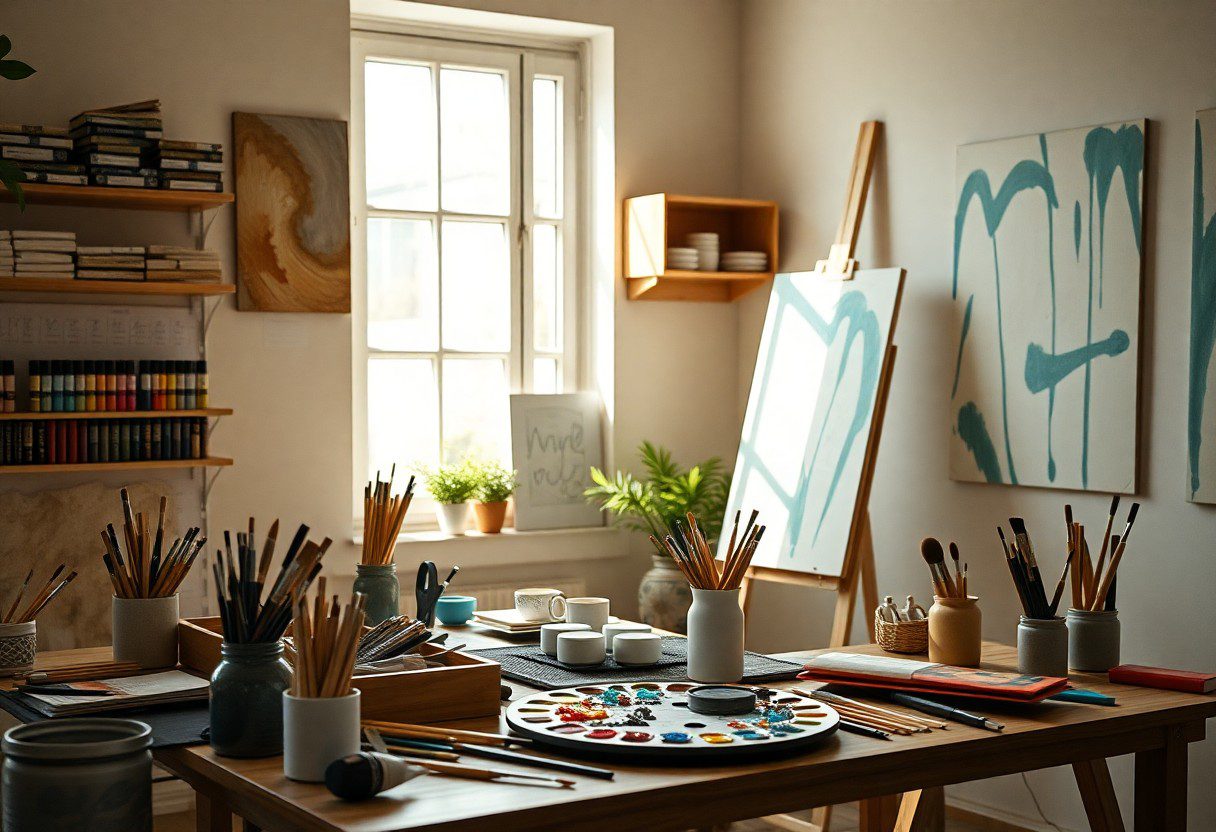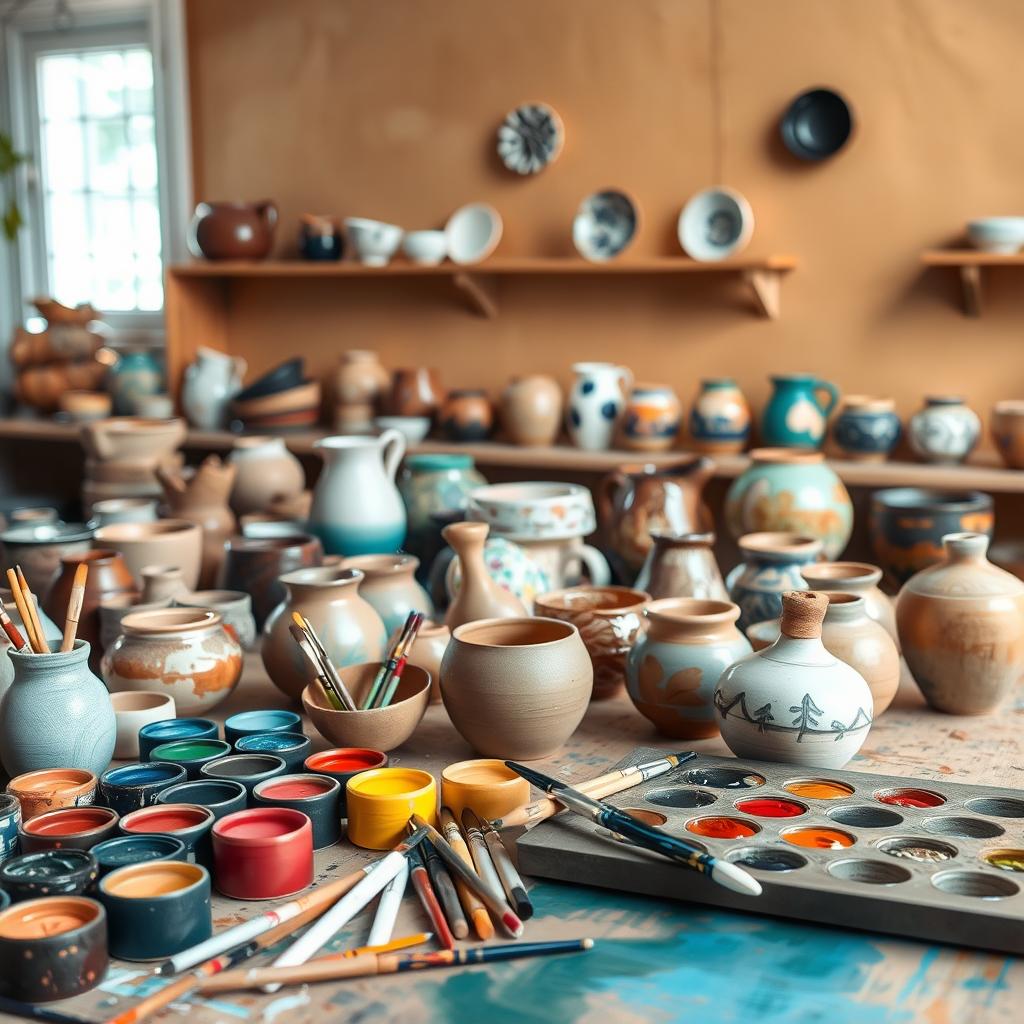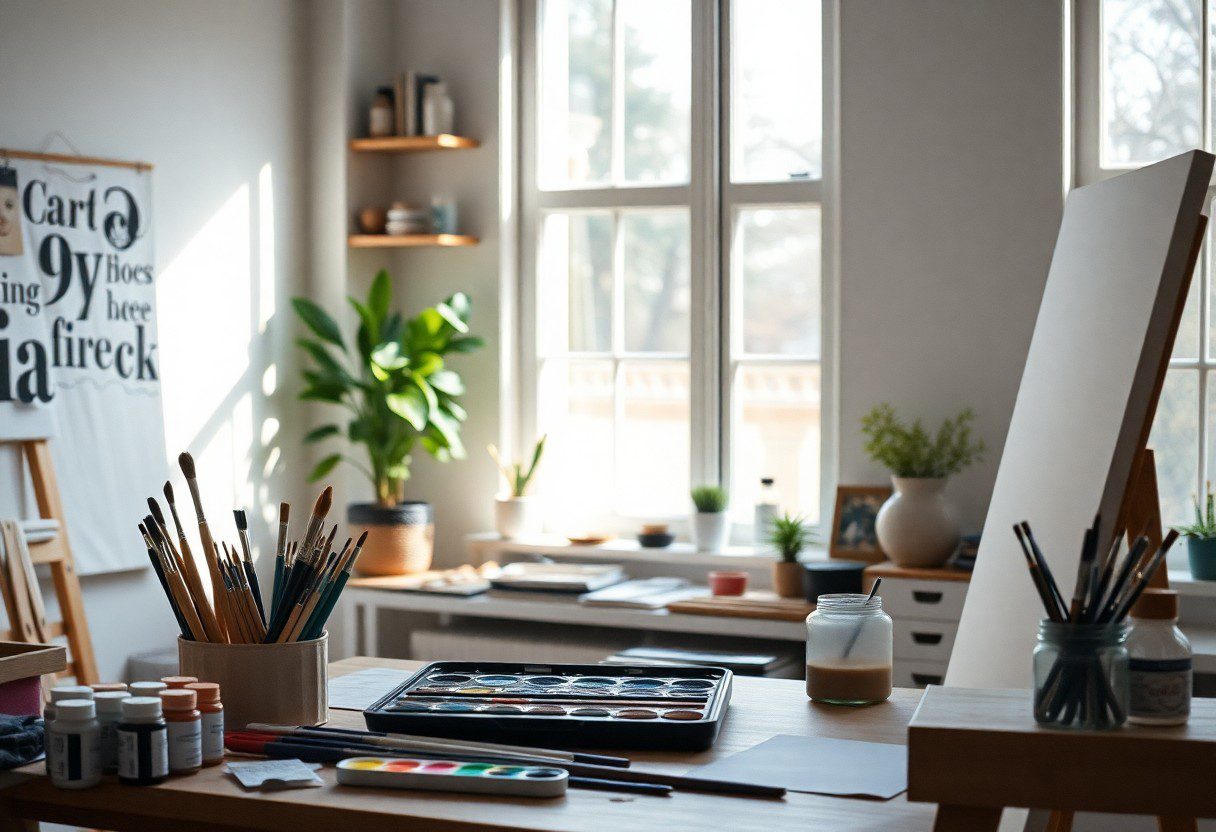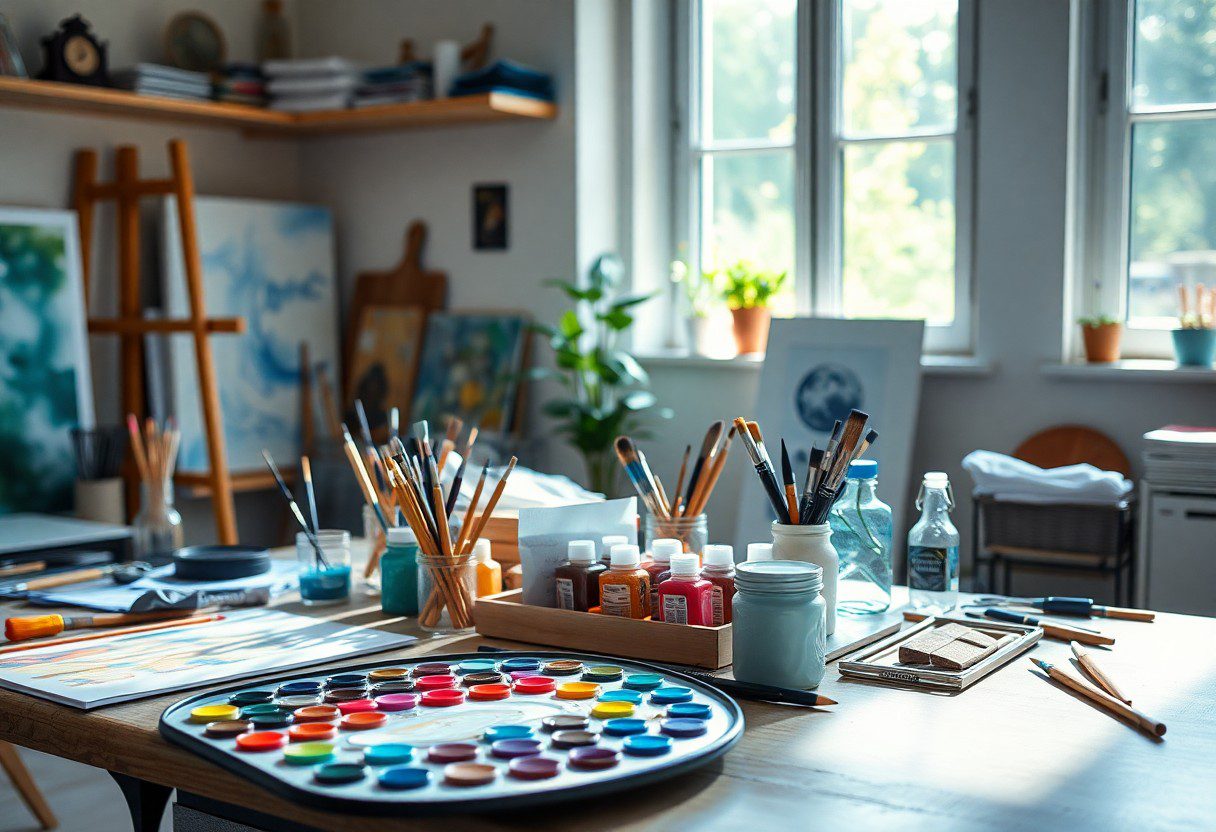Many aspiring artists find themselves wondering what they need to begin their journey in acrylic painting. In this guide, you’ll discover the imperative supplies that will unlock your creativity and fuel your artistic expression. From choosing the right paints and brushes to understanding the importance of the right canvas, you’ll learn how to set up your workspace for success. With the right tools and knowledge, you can transform your artistic vision into reality and enjoy the satisfying process of creating vibrant artwork.
Understanding Acrylic Paint
While venturing into the world of painting, it’s imperative to grasp the fundamentals of acrylic paint. This versatile medium is known for its quick-drying properties and adaptability, making it favorable for artists at all levels. Acrylics can mimic the characteristics of both watercolor and oil paints, providing you with boundless creativity in your art-making journey.
Properties of Acrylic Paint
Properties of acrylic paint include its water-based nature, fast drying time, and high versatility. With the ability to be thinned with water or used straight from the tube, acrylic paint allows for a variety of textures and effects. It dries to a flexible, durable finish, making it suitable for use on multiple surfaces.
| Property | Description |
| Water-Based | Easily thinned & cleaned with water. |
| Fast Drying | Dries quickly, allowing for layering. |
| Flexible | Dries to a durable finish. |
| Versatile | Works on various surfaces (canvas, wood). |
| Mixable | Blend easily with other colors. |
Types of Acrylic Paint
Against the backdrop of creative exploration, you’ll discover various types of acrylic paint designed for different applications. From standard heavy-body acrylics to fluid varieties, each type offers unique properties that cater to your individual painting style.
- Heavy-body acrylics – Thick consistency; ideal for texture.
- Fluid acrylics – Thinner; perfect for washes and glazing.
- Student-grade acrylics – Affordable; suitable for practice.
- High-flow acrylics – Very fluid; excellent for fine details.
- Interaction acrylics – Unique formulas; incorporate water and mediums.
| Type | Description |
| Heavy-body | Thick and textured, great for impactful strokes. |
| Fluid | Low viscosity; ideal for detail work. |
| Student-grade | Cost-effective; good for beginners. |
| High-flow | Very liquid; perfect for airbrushing and fine details. |
| Interaction | Unique formulation; reacts with water and other media. |
Further venturing into the types of acrylic paint, you will find that understanding their distinct qualities empowers you to choose the right one for your project. Experimenting with these variations can enhance your skills and provide you with immense control over your creative expression.
- Texture – Discover tactile elements in your work.
- Transparency – Varying opacity gives depth.
- Application – Different techniques require specific types.
- Drying time – Consider how quickly you want your layers set.
- Color mixing – Master the blending of shades.
| Aspect | Impact |
| Texture | Creates dimension in artwork. |
| Lightfastness | Permanence when exposed to light. |
| Viscosity | Affects how paint flows and covers surfaces. |
| Color intensity | Vividness of hues used in your art. |
| Finish | Mattes vs. glosses; defines overall look. |
Knowing the types of acrylic paint and their properties allows you to harness your artistic vision effectively. As you explore these mediums, play with them to develop your unique style and make a compelling statement through your art.
Essential Tools for Acrylic Painting
Assuming you’re ready to investigate the world of acrylic painting, having the right tools can greatly enhance your artistic journey. Along with your creativity, you’ll need some necessary tools to help bring your visions to life. From brushes to surfaces, ensuring you have the proper equipment not only ensures a smoother painting process but also elevates the quality of your art. The right tools can inspire your creativity and make your painting experience more enjoyable.
Brushes
Beside your canvas, the type of brushes you choose can dramatically affect your painting’s outcome. Different brushes serve various purposes; flat brushes work well for bold strokes, while round brushes are perfect for details. Investing in a variety of brush shapes and sizes allows you to explore diverse techniques and styles, ultimately enriching your artwork.
Palettes and Surfaces
Behind every great artist is a well-chosen palette and surface. Your palette is where you mix colors and experiment with blends, while your painting surface—be it canvas, wood, or acrylic paper—sets the stage for your artwork. Choosing the right combination greatly impacts your creative process and the final result.
To effectively mix and apply your acrylic paints, using a palette that suits your style is necessary. Options like disposable palettes offer convenience, while a glass palette allows for easy cleanup and longevity. When identifying your painting surface, consider canvas boards for durability or watercolor paper for flexibility. Each choice affects the painting medium’s interaction and your application technique, so select wisely to achieve the desired texture and finish in your artworks.
Preparing Your Workspace
If you want to unleash your creativity, organizing your workspace is key. A well-prepared environment not only enhances your focus but also inspires your artistic flow. Begin by choosing a space that feels inviting and promotes your creativity, whether it’s an empty corner of a room or a separate studio. Make sure you have ample natural light and access to water for easy cleanup.
Setting Up a Dedicated Studio
Dedicated spaces enhance your artistic journey. By setting up a studio, you create an area free from distractions, allowing your creativity to flourish. Personalize it with your favorite colors, artwork, and tools, creating an atmosphere that motivates you to paint. The more you use this space, the more it becomes a sanctuary for your creative expression.
Organizing Your Materials
Below, explore how to efficiently organize your painting materials to streamline your creative process. Keeping your supplies accessible and sorted allows you to gather inspiration without frustration.
Studio organization is imperative for a productive painting session. Start by grouping similar items together, such as brushes, paints, and canvases, to create a cohesive workspace. Use sturdy containers and labels to keep your materials easily identifiable and within reach. Always store your acrylic paints upright to prevent spills, and consider implementing a system for disposing of toxic substances, like old brushes soaked in chemical cleaners. This will not only keep your workspace tidy but also ensure safe and efficient access to the supplies that elevate your artistry.
Basic Techniques for Beginners
All aspiring painters can benefit from understanding basic techniques to lay a solid foundation for their creative journey. These fundamental skills, such as blending, layering, and brushwork styles, will elevate your acrylic painting and help you express your unique artistic vision. By practicing these techniques, you will gain confidence and agility in using your materials, allowing you to unlock your full creative potential.
Blending and Layering
Techniques like blending and layering enable you to create depth and texture in your paintings. Blending involves smoothly transitioning colors and tones, which can give your artwork a more harmonious look. Layering, on the other hand, allows you to build up colors in transparent or opaque ways, resulting in dimension and richness. By mastering these methods in acrylics, you’ll develop a versatile style that enhances your artistic expression.
Brushwork Styles
Between the variety of brushwork styles available, you have the opportunity to create both subtle and dynamic effects in your acrylic paintings. Each style offers various textures and appearances, from broad strokes to fine details. Experimenting with different brushes and pressure techniques can yield surprising results, allowing your personal style to shine through.
With every brushstroke, you can explore unique textures and expressive effects that play a vital role in your artistic process. Using a flat brush can produce bold, sweeping lines, while a round brush offers the ability to create fine details and intricate patterns. Additionally, using techniques like dry brushing adds a sense of texture to your work, while scumbling can create an ethereal quality. By embracing these diverse brushwork styles, you will develop a distinctive voice in your acrylic painting journey that captivates viewers and enhances your creativity.
Color Theory and Mixing
Not mastering color theory can hinder your artistic growth. Understanding the balance of colors allows you to create visually appealing pieces that resonate with your audience. When you grasp how colors interact, blend, and contrast, you unlock new dimensions in your acrylic painting. Next, you’ll discover how to effectively mix colors, enhancing your palette for stunning results.
The Color Wheel
Wheel your way through the basics of color theory by familiarizing yourself with the color wheel. This visual guide helps you understand primary, secondary, and tertiary colors, serving as a foundation for color mixing. By knowing complementary and analogous colors, you can make informed decisions that bring harmony and vibrancy to your artwork.
Mixing Acrylics
Any artist can elevate their work by understanding how to mix acrylic paint effectively. The beauty of acrylics lies in their ability to blend seamlessly, allowing you to create an extensive range of shades and tones. With a palette knife or a brush, you can combine colors to achieve desired effects, whether that’s soft pastels or bold, vibrant hues.
At the mixing stage, always test your blends on a separate piece of paper to visualize the outcome before applying them to your canvas. Avoid over-mixing, which can lead to muddiness—sometimes, a little texture adds depth. Utilize a limited palette to foster creativity, but don’t shy away from experimenting with combinations to find your unique voice and distinct color palette. Embrace the freedom of exploration, and watch your artistic vision come to life through the magic of color mixing!
Inspiration and Creative Process
To unlock your creativity in acrylic painting, immersing yourself in various forms of inspiration is imperative. Exploring different art styles, nature, and culture can ignite your imagination, helping you to conceptualize unique ideas. Embrace the process as a journey—allow your instinct and emotional responses to guide your artistic expression, evolving your creativity with every brushstroke.
Finding Your Artistic Voice
Beside the techniques and tools, developing your artistic voice is key to crafting meaningful artwork. We all have a story to tell, and your experiences shape your creative perspective. Take time to explore different themes, colors, and subjects to see what resonates within you, letting your individuality shine through in your art.
Overcoming Creative Blocks
Around every artist, creative blocks can feel daunting; however, you have the power to push through. Identifying the root cause of these blocks—whether fear, perfectionism, or fatigue—allows you to combat them effectively. Set realistic goals, take breaks, and engage in activities that rejuvenate your mind and spirit to reflect the world as you see it.
Voice your creative thoughts passionately, as overcoming creative blocks is vital for your artistic progress. Often, self-doubt and pressure to perform can hold you back, but acknowledging these feelings is the first step to breaking free. Experiment with new techniques, take inspiration from various sources, or collaborate with fellow artists to reignite your passion. Keep in mind, the process is just as important as the final piece; allow yourself the freedom to explore, making mistakes along the way, as this is where innovation often occurs.
To wrap up
Presently, by engaging in an acrylic painting workshop, you unlock a world of creative possibilities that can enhance your artistic skills and boost your confidence. Understanding the necessarys—such as materials, techniques, and concepts—empowers you to express your unique vision on canvas. As you explore this vibrant medium, you’ll discover new ways to connect with your creativity and find joy in the process. Embrace the journey, and let your imagination flow freely, leading you to artistic growth and personal satisfaction.
FAQ
Q: What materials will I need for the Acrylic Painting Workshop?
A: For the Acrylic Painting Workshop, you will need acrylic paints in various colors, paintbrushes of different sizes, a palette for mixing colors, canvas or acrylic paper, water containers for cleaning brushes, rags or paper towels, and a smock or old shirt to protect your clothing. Additionally, you may want to bring sketching paper and pencils for preliminary drawings.
Q: Do I need prior painting experience to participate in the workshop?
A: No prior experience is necessary to join the Acrylic Painting Workshop. The workshop is designed for all skill levels, from complete beginners to those with some painting experience. Instructors will provide guidance and help participants develop their skills at their own pace.
Q: What can I expect to learn in this workshop?
A: Participants can expect to learn foundational techniques in acrylic painting, including color mixing, brushwork, and composition. The workshop will also cover various styles and approaches to painting, encouraging attendees to explore their creativity. By the end of the session, participants will have completed a painting and gained confidence in their artistic abilities.
Q: How long is the Acrylic Painting Workshop, and what is the schedule?
A: The Acrylic Painting Workshop typically lasts about 3 to 4 hours, depending on the structure of the session. It usually includes both instruction and hands-on painting time. The schedule will often feature a brief introduction, followed by guided demonstrations, practice time, and a final showcase of participants’ work.
Q: Is there any age restriction for attending the workshop?
A: The Acrylic Painting Workshop is generally open to all ages, making it suitable for both children and adults. However, if the workshop involves complex techniques or materials, it may be recommended for participants aged 12 and older. Parents are encouraged to check specific workshop guidelines to ensure a positive experience for younger attendees.





